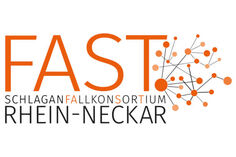Rescue services
The ambulance service plays a key role in acute stroke care. The ambulance service is essential for the following core elements:
- The most accurate clinical diagnosis and severity assessment of a stroke on site;
- optimal selection of the target hospital for acute stroke patients;
- sufficient capacity and logistics for rapid transfer to the treatment centre, but also for transfer back after treatment has been completed.
Allocation concept
The FAST SOP referral concept for acute stroke patients is to be applied within the framework of FAST. This SOP (Standardised Operating Procedure) regulates the referral concepts for acute stroke patients as part of primary operations by the emergency medical services in the Rhine-Neckar Stroke Consortium (FAST) care area. The aim is to structure and optimise treatment processes and thus make them faster, more effective and safer. The number of secondary transports required is to be reduced through optimised allocation as part of primary operations. Acute secondary transports that are still required should be given the same priority as primary transports.
You can download the following documents here or request them at FAST.RN@med.uni-heidelberg.de:
Which centre should be approached?
The decision to select the centre is the responsibility of the rescue service or the emergency medical expertise. The following algorithm can help with the decision-making process:
Within the FAST network, clinics with thrombolysis and thrombectomy facilities(intervention centres), centres with thrombolysis facilities only(partner centres) and centres without acute stroke treatment(cooperation centres) are organised. Cooperation centres should never be approached for acute stroke treatment. In principle, the hospital should be informed in advance digitally or by telephone so that the necessary patient details are already known before arrival.
The following aspects must also be observed:
- Patients with a (suspected) diagnosis of "acute stroke" should be treated as an emergency operation with special signalling . The time limit for the term "acute" is defined as 24 hours or an uncertain symptom duration that is probably less than 24 hours.
- The emergency physician should be called in for patients with impaired vigilance and those requiring acute medical treatment (e.g. hypertensive crisis, critical hypoglycaemia). The emergency doctor will decide whether a medical transport escort is also necessary.
- Time delays (of more than 10 minutes) should be avoided at all costs, e.g. by using rendezvous systems. This includes in particular the start of transport before the emergency doctor arrives.
- For patients with severe neurological deficits (suspected by the control centre dispatcher or reported back by the ambulance service/EMS), the necessary transfer to the nearest neurovascular intervention centre within the framework of FAST (centre with current thrombectomy capacity) should be calculated as soon as possible and the transport time shortened, e.g. by early dispatch of an RTH.
- The ambulance staff collect essential information for in-hospital treatment on the structured emergency protocol for stroke patients.
- The ambulance service collects and documents the neurological status on initial contact using a scale modified for the ambulance service (sNIHSS-EMS). Electronic protocols are available for the documentation and advance transmission of essential information.
Addresses and emergency numbers
Acute stroke transports should be announced by the emergency services to the intervention and partner centres by calling the following numbers.
If an acute stroke is suspected, the ambulance service is obliged to travel to a hospital with a stroke unit. Cooperation centres should therefore not be approached in the event of acute sleep attacks as part of emergency care, as they do not have a stroke unit.
Overview of emergency and gate numbers
Intervention centres (thrombolysis, thrombectomy, stroke unit)
| Location, clinic | Neuro | Gate |
|---|---|---|
| Heidelberg, University Hospital INF 400 (Head Clinic), Heidelberg | 06221 56 39600 | 06221 56 6999 |
| Heilbronn, Klinikum am Gesundbrunnen Am Gesundbrunnen 20-26, 74078 Heilbronn | 07131 49 29700 / 29299 | 07131 49 0 |
| Karlsbad-Langensteinbach Guttmannstraße 1, Karlsbad | 07202 61 7300 | 07202 61 0 |
| Ludwigshafen, Municipal Hospital Bremserstrasse 79, Ludwigshafen | 0621 503 4004 / 4006 | 0621 503 0 |
| Mannheim, University Hospital Theodor-Kutzer-Ufer 1-3, Mannheim | 0170 5700 295 | 0621 383 4472 |
| Rastatt, District Hospital Engelstraße 39, 76437 Rastatt | 07222 389 15777 | 07222 389 0 |
| Schwäbisch Hall, Diakonie-Klinikum Diakoniestraße 10, 74523 Schwäbisch Hall | 0791 753 46 98 | 0791 753 0 |
Partner centres (thrombolysis, stroke unit)
| Location, clinic | Neuro | Gate |
|---|---|---|
| Bad Kreuznach, St. Marienwörth Mühlenstraße 39, Bad Kreuznach | 0671 372 4222 | 0671 372 0 |
| Bruchsal, Fürst-Stirum-Klinik Gutleutstraße 1-14, 76646 Bruchsal | 07251 708 57 440 | 07251 708 0 |
| Erbach, District Hospital Albert-Schweitzer-Straße 10-20, Erbach | 06062 797071 | 06062 79 0 |
| Groß-Umstadt, district hospital Krankenhausstraße 11, Groß-Umstadt | 06078 79 3200 | 0 60 78 79 0 |
| Heppenheim, KKH (Bergstraße) Viernheimer Straße 2, Heppenheim | 06252 701 92 444 | 06252 701 0 |
| Öhringen, Hohenloher Krankenhaus Kastellstraße 5, 74613 Öhringen | 07941 692 8011 / 8572 | 07941 692 0 |
| Mosbach, Neckar-Odenwald-Kliniken Knopfweg 1, Mosbach | 06261 838166 | 06261 83 0 |
| Pforzheim, HELIOS Klinikum Kanzlerstraße 2-6, Pforzheim | 07231 9693551 | 07231 969 0 |
| Sinsheim, GRN Alte Waibstadter Straße 2, Sinsheim | 07261 66 17 111 | 07261 66 0 |
